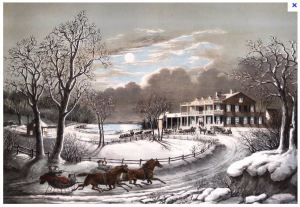Why do parties choose a moonlit night for sleigh rides? Because they are pleasanter than dark nights. “Proceedings of the Farmers’ Club” in the Annual Report of the City of New York 1864 p. 165.

Here it is December 15, and no snow, no snowmen, and no sleds. I am looking out my window at green grass. With global warming that’s becoming an expected occurrence here in upstate New York. Not so in the 1860s. Local farmer Isaac Hurlburt recorded in his diary heavy snow on October 29, 1862.
Farmers like Isaac Hurlburt couldn’t wait for the ground to freeze and the snow to fall. People could put away their wagons and get out the wood sleds and sleighs. No more mud and ruts to sink in or bounce over in unsprung wagons and carriages, just smooth white snow, the sound of the runners flying silent in the freezing air. Time to go a-visiting under the full moon!
It was the time of “the occasionally spitting snow as from very spite, and the hoarse north wind piped in doleful notes and the birth of the season of storms and snowdrifts, and sleigh-rides and singing-schools.” (William Bacon The Cultivator 1861)
Winter travelers wrapped themselves in blankets, furs, and packed hot bricks to keep warm on rides that might take up to a day with a stop at an inn or friend’s home to warm up mid-day. The jingle of the bells inspired one of the most well-known songs of winter “Jingle Bells”. But the sleigh bells were not just for effect. They were required by law because the sleds traveled so fast and so quietly. The horse team pulling the sleigh needed to have strong legs and special shoes. A two-horse, six person sleigh weighted about 600 pounds. (Joan Gilbert “Driving Sleighs”).
City people appreciated the comforts of the sleigh as well. The following excerpt of a sleigh ride from New York City to the upscale resort of Hoboken New Jersey is from the 1864 novel by Clarence Gordon Christmas at Under-Tor: An American Christmas Story. (p. 15)
It was nearly three o’clock in the afternoon when – after the tedious winding through crowded streets – we sat in our sleigh on the Hoboken ferry-boat… the ladies took that opportunity on the boat to settle their hoops and tuck their furs snuggly around them. My reverend cousin, Stuyvesant, and I, looked out over the snow-crusted wheelhouses at the gray, velvety surface of the river – the rugged Palisades, edging it in brown outline above, and below a forest of frosted masts; puffing tugboats; the smooth, flat islands with their fortress crowns. The horses impatiently swung their necks, jingling in jerks the full string of bells.
We were ashore, soon, past the Elysian fields, ice cream and oyster saloons, and the pretentious villas of Hoboken – all the country wrapped in snow. “Ger-lang. Step out colts.” Jingling with such evident merriment to the movement, the bells (I had taken care to secure plenty of them) brought appreciative curves of sympathy about every mouth. So plainly it was expressed as we instinctively glanced at one another, there was no need to speak it all at once – “How nice!”
Sigh, it sounds more than nice. Now if only we had some snow…

Learn more…
History of the song Jingle Bells written in 1857
History of working sleighs in Maine
Driving a Sleigh

Well, I sure like the sound of life with sleighs! Can’t read the middle excerpt as the green color is too pale….otherwise, the piece made my senses jingle!
LikeLike
I have fixed the color of the text. Hope that helps. Hope the bells are jingling where you are. Joan
LikeLike